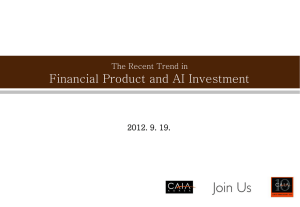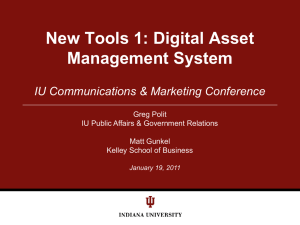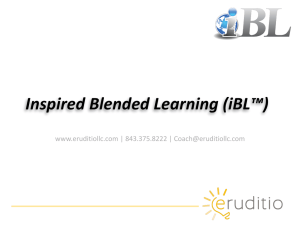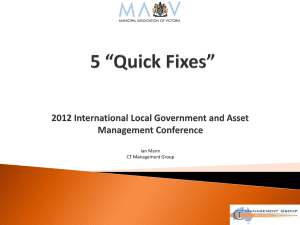here - Personal Finance
advertisement
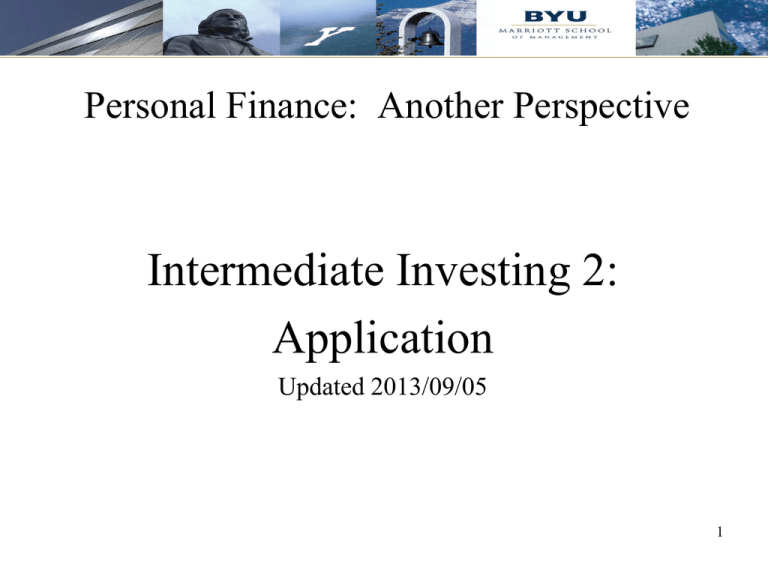
Personal Finance: Another Perspective Intermediate Investing 2: Application Updated 2013/09/05 1 Objectives • A. Understand how to apply the key principles to your personal investing: • 1. Selecting asset classes • 2. Building an investment portfolio • 3. Selecting investment vehicles • 4. Determining your asset allocation (or your risk level) • 5. Selecting individual assets 2 A. Understand how to Apply Key Principles • Investing is similar to an amusement park. • People go (invest) on rides in areas they like: • Higher risk investments are like the roller coaster--they require a stronger stomach, but the thrill (and return) is generally much greater • Lower risk investments are like the merry-goround. While they are fun, they may be too sedate for some investors. Other rides are inbetween • The key is to find out what you like to ride on, as well as to ride the rides that will help you accomplish your goals, i.e., retire with dignity, save for retirement, put your kids through college, etc.! 3 Applications 1. Selecting Asset Classes • What are asset classes? • Asset classes are broad categories of investments with specific (and similar) risk and return characteristics • How are they distinguished? • Asset classes are distinguished by characteristics specific to particular groups of securities, such as type of financial instrument, market capitalization, maturity, geographic location, etc. • What are the major asset classes? • Cash and cash equivalents, fixed income, and equities 4 Asset Classes (continued) • Application • Always be diversified in your investing—don’t put all your financial assets or “eggs” in one basket • Invest in many different asset classes in your portfolio such as: • Equities: large cap, small cap, international, emerging markets, etc. • Bonds: taxable, tax-free; short-, med-, and longterm corporates; short- and long-term governments, etc. • Cash: money market, CDs, savings, MMMFs, etc. 5 Applications 2. Building a Portfolio • Portfolio selection strategies will differ by individual, portfolio manager, institution and view of the market • It is impossible to discuss how every portfolio manager builds every portfolio • But general concepts and principles are applicable to everyone • As I review the successful investment portfolios of the past, there appears to be a pattern. I call it the bottom of the Investment Hourglass 6 Successful Investing: the Hourglass Bottom Taxable Assets Retirement Assets 4. Opportunistic: Individual Stocks and Sector Funds (this is totally optional) 3. Diversify: Broaden and Deepen your Asset Classes 2. Core: Broad Market Equity Index Fund/ETF, or Core Mutual Funds 1. Basics: Emergency Fund and Food Storage 7 The Investment Hourglass (continued) • Application: The investment hourglass bottom teaches 3 important lessons: • 1. It helps keep risk in perspective • It starts investing from lowest risk to highest risk • 2. It teaches the “how to” about investing? • You invest first in lower-risk assets, and then move up to more risk as your assets (and investment experience) increase • 3. It separates out taxable and retirement assets • Retirement and taxable assets should be managed differently due to taxes and time horizon 8 Applications 3. Selecting Investment Vehicles (for investing and retirement) • Why is selecting investment vehicles important? • Selecting the right investment vehicles can help you achieve your investing goals faster • Why should we learn it? • Investment vehicles have different benefits, i.e., due to matching (free money), tax avoidance, tax deferral, or just tax-efficient and wise investing. • The wise use of correct investment vehicles will help you save more money to help you reach your financial goals faster 9 Selecting Investment Vehicles (continued) • What is the difference between investment vehicles and financial or investment assets? • The investment vehicle is the tax-law defined framework that has specific tax advantages, i.e., 401k, 403b, Individual Retirement Account (IRA), SEP IRA, Roth IRA, Roth 401k, etc. • The investment vehicle is the shopping cart • The financial assets are the securities that are invested in by the vehicles, i.e., stocks, bonds, mutual funds, REITs, MMMFs, CDs, etc. • The financial assets are the groceries you put in the shopping cart 10 Selecting Investment Vehicles (continued) Select Investment Vehicles for 2013 (before catch-up) TaxTax- Maximum Plan deferred eliminated Amount For Employees of: 401-k Y $17,500 Businesses w/plans Roth 401-k Y 17,500 Businesses w/plans 403-b Y 17,500 Non-profit, tax-exempt Roth 403-b Y 17,500 Non-profit, tax-exempt 457 Y 17,500 State/municipalities SEP IRA Y 51,000 Small businesses SIMPLE IRA Y 12,000 Small businesses IRA Y 5,500 Individuals Roth IRA Y 5,500 Individuals Education IRA Y 2,000 Individual Education 529 Plans Y >390,000 p.c. Individual Education Selecting Investment Vehicles (continued) First priority: Free money • Money that is made available by your company, generally on a matching basis, to encourage greater participation in company sponsored retirement plans, i.e., 401k, Roth 403b, Keogh, etc. • Money made available through tax benefits, i.e. 529 contributions which are deductible from state taxes What are the risks? • You must stay at the company a certain number of years to become fully vested, i.e., to be able to take full ownership of these funds, or use the funds for education expenses for 529 plans 12 Selecting Investment Vehicles (continued) Second Priority: Tax-advantaged money • a. Elimination of all future taxes • This money can be used at retirement (or for education) without penalty and without taxes, i.e., Roth IRA or Roth 410k/403b for retirement, and 529 Funds and Education IRA for education • In addition, with the Roth, you can take the principle out without penalty at any time What are the risks? • You must be 59½ to receive earnings • Money from 529 Funds, Education IRA, and EE/I bonds must be for qualified educational expenses to be tax-free 13 Selecting Investment Vehicles (continued) b. Tax-deferred money: • This money has the ability to be invested beforetax, with principle and earnings taxed only at retirement (IRA, SEP IRA, etc.) What are the risks? • You must be 59½ to take distributions. If you take the funds out before retirement, there is a 10% penalty and funds are taxed at your ordinary income tax rate for both federal and state • This money converts long-term capital gains into short-term income for tax purposes 14 Selecting Investment Vehicles (continued) Third Priority: Tax-efficient and wise investments • This is money that is invested tax-efficiently and wisely, consistent with the investment principles discussed earlier • What are the risks? • Earnings are taxed consistent with the assets invested in • You need to take into account the tax and transaction cost implications of whatever you invest in 15 Selecting Investment Vehicles (continued) • How do you invest tax efficiently? • 1. Know the impact of taxes • Its what you earn after taxes that is critical • 2. Look to Capital Gains—defer earnings and taxes to the future • Capital gains are taxed differently • 3. Minimize Turnover and Taxable Distributions • Turnover creates taxes on distributions • 4. Replace interest income with stock dividends • Stock dividends are taxed differently • 5. Invest tax-free 16 Selecting Investment Vehicles (continued) • Application: In which vehicles should you put different types of financial assets? • Retirement Accounts: 401k, IRA’s (both Roth and traditional), 529 Funds, etc. • Financial assets in which you trade actively • Taxable bonds and high turnover mutual funds • You do not pay taxes until you take out funds • Taxable Accounts: investment portfolios • Stocks and mutual funds with a buy and hold strategy • Tax-free bonds and tax-efficient index funds • You pay taxes on these distributions yearly 17 Application 4. Determining Your Risk: Your Asset Allocation • What is risk tolerance? • Risk tolerance is an investor’s willingness to accept risk • It is related to the holdings of the investor’s investment portfolio or their expected holdings in their investment portfolio, particularly their asset allocation or asset mix • Higher risk tolerance indicates a willingness to take on more risk • Lower risk tolerance indicates a willingness to take on less risk 18 Asset Allocation (continued) • How is risk tolerance determine? • Risk tolerance is determined in two main ways: • 1. It can be derived from an investor’s age and their current portfolio holdings, i.e., an implied risk tolerance • 2. It can be estimated by an investor answering specific questions regarding investor demographics including age, characteristics, spending habits, history, and investment experience Asset Allocation (continued) • What do you mean by risk in the determination of risk tolerance? • Risk in this case is generally considered the volatility of investment returns • Investors with a lower risk tolerance will have more assets in less risky or less volatile asset classes such as bonds and cash • Investors with a higher risk tolerance will have more assets is more risky or more volatile asset classes such as equities or stocks including small caps, international, REITs, etc. Asset Allocation (continued) • Is risk tolerance an absolute number or a general category? • For the purposes of this class and lecture, risk tolerance is considered more a general category • In this class, we divide risk tolerance into five categories: • Very conservative • Conservative • Moderate • Aggressive • Very aggressive 21 Asset Allocation (continued) • What is the purpose of risk tolerance? • The purpose of risk tolerance is to enable that investor to determine an appropriate asset allocation or investment mix based on the investor’s willingness to accept risk • This allocation is critical because it determines the amount of risk an investor is willing to accept • A lower risk tolerance should lead to a lower risk portfolio, with more invested in bonds and cash • A higher risk tolerance should lead to a higher risk portfolio with more equities 22 Asset Allocation (continued) • What is the challenge of risk tolerance? • Risk tolerance is not an exact science, and can mean different things to different people • Risk tolerance varies from one individual to another • There are many different risk tolerance tests and categories that may lead to slightly different results • There are lots of different risk tolerance tests available online, many of which are more to sell investment products than to really help people understand how they should invest their assets • Luckily, we are not selling anything 23 Asset Allocation (continued) • What is asset allocation? • It is the process of determining how the assets of a portfolio are divided, mainly into which asset classes • A well diversified portfolio should have broad diversification across many asset classes to reduce overall portfolio risk • A broadly diversified portfolio is an investor’s key defense against risk, a key to a “sleep-well portfolio” 24 Asset Allocation (continued) • Why is asset allocation so important? • Asset allocation is important for two reasons: • 1. Research has shown that most of the returns from financial assets are mainly a function of returns from the specific asset class decision, and not from the individual stock selection decision • Asset class choice influences returns • 2. In the process of selecting your asset allocation, you are selecting your risk level for your overall portfolio • Selecting asset classes is selecting the risk or risk level for your portfolio 25 Asset Allocation (continued) • What were the most risky asset classes over the past 85 years ending December 2012: • Asset Class US Small Cap US Large Cap Treasury Bonds Treasury Bills Inflation Return* Standard Deviation* 12.0% 9.5% 5.6% 3.6% 29.1% 19.2% 8.4% 0.9% 3.1% 1.8% • Source: Calculated from Ibbotson • Note that these are portfolios of financial assets, not individual assets 26 Asset Allocation (continued) • What were the most risky asset classes over the past 10 years ending December 2012: • Asset Class Return* Standard Deviation* Other: US REIT 13.0% Equity: Emerg. Markets 15.2% Equity: US Small Cap 10.3% Equity: International 3.8% Equity: US Large Cap 7.1% Govt: Treasury Bonds 7.3% Govt: Treasury Bills 1.7% Inflation 2.4% 27.6% 24.3% 20.8% 18.4% 14.9% 12.0% 0.5% 1.5% • Source: Calculated from Ibbotson and MSCI. These are portfolios of financial assets, not individual assets 27 Asset Allocation (continued) • What is the process of determining your asset allocation? Where does risk tolerance come in? • Asset allocation is a three-step process: • Step 1: Set your initial bonds and cash allocation to equal your age as a percent of your overall portfolio allocation • For example, if you are 40 years old, you should have 40% of your portfolio in bonds and cash, and 60% in equities 28 Asset Allocation (continued) • Step 2: Take this risk tolerance test • Based on your results, you will adjust that allocation to take into account your individual risk tolerance and come up with an riskappropriate asset mix • If you are more conservative you will increase your bonds and cash allocation and decrease your equity allocation • If you are more aggressive, you will do the opposite 29 Asset Allocation (continued) • Step 3: Determine your preferred asset classes based on risk within your major asset classes • If you are a conservative investor, you will likely have many different bond asset classes (short-term, long-term corporates, governments, municipals, etc., but likely only large cap equities, and perhaps a small amount of other equity asset classes • If you are more aggressive, you will do the opposite, have more small cap, international, emerging markets, REITs, etc. 30 Asset Allocation (continued) • I recommend you take a risk tolerance test (Teaching Tool 16 from the website) • 1. Review each of the 8 questions • 2. Honestly answer each of the questions • 3. Then add up your points from each question • Please note that there are five potential responses to each question, worth 1 to 5 points • Add up the point next to the correct response and sum your total points from 8 questions • 4. From your total points, we will have recommended actions for your asset allocation • Now take the test! 31 Asset Allocation (continued) • You now have your total score • From your total score, it can help us understand what type of investor you are: Very conservative, Conservative, Moderate, Aggressive, and Very aggressive • Each score will have a recommended action regarding increasing or reducing risky assets • Now match your beginning allocation, which is your age in bonds, with your recommended action. • Once you perform the recommended action, you will have your asset allocation or asset mix consistent with your preferred level of risk 32 Asset Allocation (continued) • Very Conservative • Cash Bonds Stocks +5% +15% -20% • Conservative • Cash: Bonds: Stocks: (13 to 20 points) +0% +10% -10% • Moderate • Cash Bonds Stocks (8 to 12 points) (21 to 28 points) 0% 0% 0% 33 Asset Allocation (continued) • Aggressive • Cash Bonds Stocks • Very Aggressive (29 to 36 points) -5% -5% +10% (37 to 40 points) • Cash -5% Bonds -15% Stocks +20% • Investors are free to shift between the cash and bond allocations without any change in effectiveness of the test. I personally prefer to always have, at minimum, a 5% allocation to cash 34 Asset Allocation (continued) • How does this scoring work? • For example, if you scored 35 points, you would be considered a “aggressive” investor • This is your risk tolerance or type of investor • To get to your asset allocation or asset mix: • Start with your age in bonds. For example, assume your are age 40 so assume 40% in bonds • Next, do what the results suggest. For an “aggressive” investor, you would add 10% to equities and subtract 10% to your bond and cash allocations from the above charts • Your asset allocation at age 40 would be 30% bonds and cash, and 70% equities 35 Asset Allocation (continued) • Can you have two individuals with similar asset allocations yet with different risk levels? • Yes. This is due to their different ages • For example, three investors each have a 60% equity and 40% bond allocation • Investor A is age 50 and is Aggressive • Investor B is age 60 and is Moderate • Investor C is age 40 and is Very aggressive • Please note that their allocations within the equity and bond allocations will likely be very different • Aggressive investors will have more small cap, international, and other risk equity asset classes 36 Application 5. Selecting Assets • What type of assets should you choose? • This depends on the size of your investment portfolio • When should you pick individual stocks? • I recommend you generally avoid picking individual stocks and bonds until your portfolio is sufficiently large (i.e., $500,000 or more). You actually can have a successful portfolio without purchasing individual stocks and bonds • Why is this the case? • There are five major reasons why I do not recommend picking stocks when your portfolio is small 37 Selecting Assets (continued) • 1. Principle 3: Stay Diversified • Picking single stocks violates the principle of diversification, especially when you are just beginning to build your portfolio • With a small portfolio, it is difficult to achieve acceptable diversification with limited numbers of stocks 38 Selecting Assets (continued) • 2. Principle 4: Invest Low Cost • Investing in stocks when you have a small portfolio is very expensive • Transactions costs for purchasing stocks are among the highest of any major asset class 39 Selecting Assets (continued) • 3. Principle 6: Know What You Invest In • Picking stocks when you have not developed the knowledge base necessary to evaluate stocks is very risky, bordering on speculation or gambling • Most have not as yet put in the time to learn to evaluate stocks nor have developed the tools to make good stock selection decisions (this includes most of my finance students unless they have taken my Finance 409/415 classes) 40 Selecting Assets (continued) • 4. Principle 8: Don’t spend too much time trying to “Beat the Market” • Picking stocks is very difficult and challenging • There is so much more to be learned about valuation that can’t be taught in a single presentation on investing • I have given only the very basics in this presentation 41 Selecting Assets (continued) • 5. Stock selection is not required to have a successful investment portfolio • While it is intellectually challenging to select stocks, you can generally improve returns and reduce risk more by properly selecting asset classes and buying no-load mutual and index funds • You may never need to buy an individual stock • I have no individual stocks in my portfolio (except what I do with the students) 42 Selecting Assets (continued) • What are index funds? • Mutual funds or ETFs which hold specific shares in proportion to those held by an index • Their goal is to match the benchmark performance • Why have they come about? • Investors are concerned that most actively managed funds have not been able to beat their benchmarks after all fees, taxes and costs on a consistent basis 43 Selecting Assets (continued) • Why the big deal about index funds? • Index funds have become the standard against which other mutual funds are judged • If an actively managed mutual fund cannot perform consistently better (after taxes and fees) than an index fund from the same asset class, then investors should invest in index funds • Remember from the Dalbar study that most investor’s have underperformed the performance of the benchmarks (see Dalbar 2007-2012). 44 Selecting Assets (continued) • Why have index funds and ETFs grown so quickly? • They have outperformed most actively managed funds after fees, taxes and expenses • Winners rotate--there is no correlation between last year’s winners and this year’s winners for actively managed funds • Actively managed funds reduce performance through excessive trading and high fees • Experience has shown it is very difficult to beat index funds on a consistent basis after all fees and taxes 45 Selecting Assets (continued) • Jason Zweig, a senior writer for Money Magazine commented: • With an index fund, you're on permanent autopilot: you will always get what the market is willing to give, no more and no less. By enabling me to say "I don't know, and I don't care," my index fund has liberated me from the feeling that I need to forecast what the market is about to do. That gives me more time and mental energy for the important things in life, like playing with my kids and working in my garden (Jason Zweig, “Indexing Let’s You Say Those Magic Words,” CNN Money, August 29, 2001). 46 Selecting Assets (continued) • Warren Buffet commented: • By periodically investing in an index fund, the know-nothing investor can actually outperform most investment professionals. Paradoxically, when 'dumb' money acknowledges its limitations, it ceases to be dumb (Warren Buffett, Letter to Berkshire Hathaway Shareholders, 1993). 47 Selecting Assets (continued) Application: • Most actively managed funds will generally underperform index funds in the long run after all taxes, costs and fees • The competition in stock-market research is intense and will get more competitive going forward, making markets more efficient and indexing even more attractive • Buying an index fund or “passive investing” is a freeride on the competition • Passive investing takes very little time and has generally outperformed most actively managed funds 48 Selecting Assets (continued) • Remember, since analyzing companies is not likely going to be many of your jobs, it will be in most of your best interests to develop a “sleep-well portfolio” plan and follow it. This is done by: • Living on a budget and saving monthly • Investing regularly for your family goals • Staying diversified and investing low cost and tax efficiently through index funds consistent with your level of risk • Writing and following your Investment Plan • Enjoying your family and friends • Doing well in your day job, church 49 Final Cautions • Final thoughts: • Do not go into debt to invest • This includes taking equity out of your home • Beware of financial advisors who recommend shifting assets from one vehicle to another • Don’t shift from a 401k, paying penalties, to another financial asset • Beware the agency problem • Some advisors sell products based on their commissions, not what is best for you • Listen to the spirit • If it seems too good to be true, it probably is 50 Application Lessons from Application of Principles • 1. There is a logical and consistent process to building your investment portfolio. Since asset classes have different risk and return characteristics, you must we wise in your choices of asset classes so you can obtain the return you need to accomplish your personal and family goals. While the top of the “investment hourglass” was priorities based, the bottom of the investment hourglass is risk based. • 2. Taxable and retirement assets should be managed differently due to the impact of taxes. You will not have just one portfolio of investment assets. You will likely have many separate individual investment portfolios that all added up to your total investment portfolio. 51 Application Lessons (continued) • 3. Different investment vehicles have different tax advantages. You are responsible for understanding the various investment vehicles available to you so you can make the best decision as to which vehicles to use. The proper choice of investment vehicle can help you to attain your financial goals faster. • 4. Utilize the investment vehicles that give you the highest after-cost and after-tax return. Taxes and investment expenses are a drag on returns and reduce the amount of money that you have for your personal and family goals. 52 Application Lessons (continued) • 5. It is critical that you develop an investment portfolio that eliminates your “fear” and “greed”. Determine your risk tolerance, then choose your asset allocation consistent with that risk tolerance. Be wise in your choice of asset classes so that you can have a diversified portfolio that will be around for until you retire. 53 Application Lessons (continued) • 6. Don’t get into the habit of chasing returns. The best performing fund last year will not be the best performing fund this year. Follow the principles of successful investing, including investing low cost and tax efficiently, not trying to beat the market, investing in low-cost index funds and ETFs, and not buying individual stocks and bonds until your portfolio is larger (generally, greater than $500,000). Remember you can have a successful portfolio without investing in individual stocks and bonds. 54 Review of Objectives (continued) • A. Understand how to apply the key principles to your personal investing: • 1. Selecting asset classes • 2. Building a portfolio • 3. Selecting investment vehicles • 4. Determining your asset allocation or your risk level • 5. Selecting financial assets • 6. Final cautions 55




